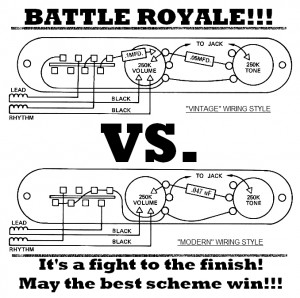Occasionally we’re asked whether we suggest that our customers wire their Tele’s in what is known as the “Vintage” wiring schematic (also known as “Dark Tone” or “Blackguard” styles). A simple answer: No.
Over the years there were many component changes made to the circuit, but the following diagram shows what is widely accepted as the Telecaster vintage-style schematic:
In use, the following switching applies – from player’s perspective:
Position #1 (switch to right): Bridge pickup w/tone control
Position #2 (switch in middle): Neck pickup w/ tone control
Position #3 (switch to left): Neck pickup with no tone control and treble rolled off (pre-set bassy position).
As you can see, this schematic has presets which don’t work all that well with most Tele players’ playing style and there is no position for neck and bridge combined, which has become the quintessential Telecaster tone.
Leo Fender clung tightly to this wiring design, with total disregard to growing customer demand for an alternative – which led to a lot of people modifying their own instruments to meet their needs. This remained the way it was done beyond Leo’s tenure at the reigns of Fender, until he was no longer consultant for the then CBS-owned company. Although a very small minority of guitarists were alright with the “Dark Tone” (mostly jazz players), most Tele players simply had little to no use for the factory-wired position #3 and they also longed for a neck/bridge combo. This is one time where a penny-pinching corporation attempting to maximize profits at the helm of a beloved instrument manufacturing company has paid off…
In 1967, in an attempt to cut costs by reducing the number of capacitors used, and by simplify the factory wiring process, CBS changed the wiring of the Telecaster to what is now referred to as the “Modern” wiring style, and again though the schematic continued to subtly evolve – as is Fender’s M.O. –, this is basically how it looks in diagram format:
When wired in this manner, the following switching applies – from player’s perspective:
Position #1 (switch to right): Bridge pickup alone w/ tone control.
Position #2 (switch in middle): Both pickups together in parallel w/ tone control.
Position #3 (switch to left): Neck pickup alone w/ tone control.
This wiring allows for tonal control over all three positions, as well as a neck and bridge combined in parallel in the middle position, which was basically what most Tele players were previously doing to their own guitars anyway. So CBS saved money on production and it was less work for the customers that wanted this type of setup, which until then wasn’t an option from the factory. It was a classic win/win.
As previously mentioned, there have been many small changes to the circuit design, such as capacitor and potentiometer values, etc. but in general, this wiring style has maintained its place in Tele players’ instruments due to versatility and delivery of desired tone. And though other schematics have become popular over the years (for instance, the Tele 4 way mod), the “Modern” wiring schematic remains the most common for good reason, which is why it is our preferred method.


